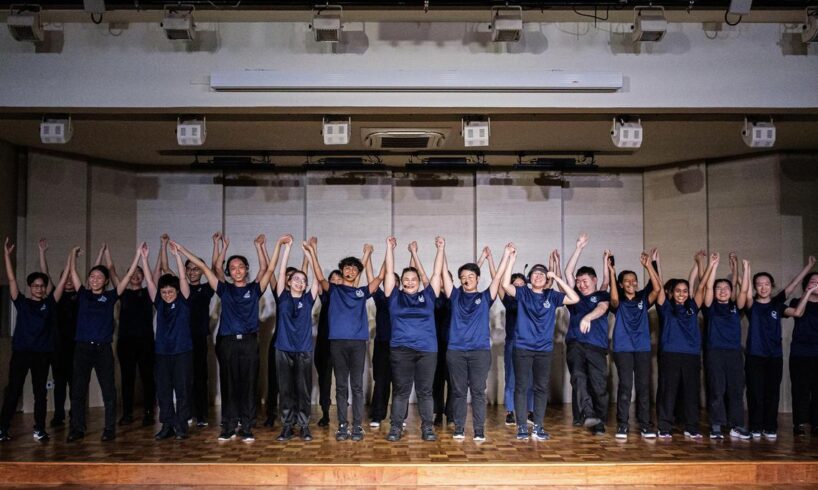
SINGAPORE – Miss Kua Ying En was working as a dental assistant in 2023 when she first encountered a deaf person.
Upon realising that the patient could not hear, Miss Kua and the clinic staff – from the nurse, to the dentist – communicated with her via pen and paper. However, the process was slow-going.
The incident stuck with her, and when the chance to join a co-curricular activity (CCA) in Singapore Polytechnic (SP) arose, the sign language club was her first choice.
Learning sign language was important, she felt, to be inclusive. “Texting and writing can really slow things down. It might not be a big issue in casual situations, but what if there’s an emergency and they need help immediately?”
Two years on, the 20-year-old banking and finance student is club president, and can sign complete sentences and hold non-verbal conversations.
SP’s club has been guided by coach Pet Tan, since it was founded in 2012. Ms Tan, who is hearing, has volunteered with The Singapore Association for the Deaf (SADeaf) for more than 27 years.
She said that most students join out of interest and have almost no background knowledge, while a handful “might have learnt a little” from lessons with SADeaf, online, or through friends.
Nonetheless, all members start at the basic stage – where they first pick up signing the alphabet, numbers, as well as common everyday words – before moving up to the intermediate and advanced levels.
Learning sign language is “not structured exactly like foreign language modules”, she said.
“But just like learning a (spoken) language, you need to understand the dos and don’ts, misconceptions, and appropriate and inappropriate terms.”
The club mainly uses Signing Exact English, which follows English grammar and word order, in their CCA sessions. Members who advance further may also use Singapore Sign Language, which is used by the deaf community in Singapore and has its own grammar and structure.
Members of the club learn sign language weekly and also take part in local community service events, where they interact with the deaf community up to five times in an academic year.
A typical CCA session begins with an icebreaker, followed by a segment on Deaf culture, Singapore Sign Language lesson, and an interactive activity that encourages the members to make friends while practising signs.
PHOTO: COURTESY OF SINGAPORE POLYTECHNIC’S SIGN LANGUAGE CLUB
Currently, 50 to 60 members regularly attend the two-and-a-half-hour basic stage lessons every Wednesday. Intermediate sessions are held after, with about 30 students at this level.
Up to 12 student instructors, Ms Kua included, take turns to conduct the CCA sessions. They are supervised by Ms Tan, who teaches the advanced group – which has six students – on Tuesdays.
At the end of the basic and intermediate levels, students keen on advancing sit for a test where they are assessed on their reading and signing skills in finger spelling and vocabulary. A question-and-answer session is sometimes included.
Only after attaining a passing score can the members move up to the next level. Though the certificates given upon passing each level are not formal certifications, they acknowledge participation and proficiency within the CCA context, said Ms Tan.
Meanwhile, advanced students, who are usually in their final year of polytechnic, are evaluated on their ability to interpret signs into written sentences, and voice to signs.
These students learn how to communicate with the deaf and interpret for them.
Among them is Ms Yue En Qi, a third-year applied artificial intelligence & analytics student who joined SP’s sign language club in 2023.
Her initial interactions with the deaf community – before she learnt more advanced sign language – left her frustrated at herself, the 19-year-old recalled.
Feeling that she did not know enough signs to hold a conversation spurred her to improve her sign language proficiency.
This year, she hit her “biggest personal milestone” during a Chinese New Year event organised by the sign language club, guiding deaf participants on how to cook food like Chinese rice balls and rice cakes.
Ms Yue added: “I could sign to them without a script, unlike the very first time, and finally have more open conversations with them.”
Second-year media, arts & design student Fin Loh, is also at the advanced level. The 22-year-old, who attended her first basic stage lesson in May 2023, said her biggest challenge is understanding what other people sign.
“The grammatical structure and expressions that we use when practising are familiar and specific to this group, and it takes more interaction with other people signing to be able to understand when they sign with different structures.”
Outside of CCA sessions, she and her sign language club friends practised by finger spelling “random words” found in MRT advertisements during their journeys home from school.
“Eventually, as we learnt more vocabulary, we could have whole conversations on the MRT without disrupting anyone because we’re not making any noise!”
In the future, she aims to be an interpreter working with teachers, children and parents.
Education “has opened up many doors for me”, she said, adding: “I believe all children deserve the same access to education and support in their growth.”





